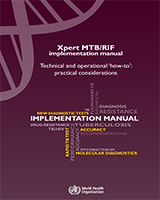The definitions and the reporting framework for TB were revised in 201334. These changes were driven primarily by a need to clarify how to register TB patients detected using molecular techniques: these changes to definitions and reporting have been reflected throughout this edition of the implementation manual. Additionally, the most important definitions relevant to this manual are presented below.
6.1. TB case
A bacteriologically confirmed TB case is a person from whom a biological specimen has tested positive by smear microscopy, culture or WHO-approved rapid diagnostics, such as the Xpert MTB/RIF assay. All such cases should be notified, regardless of whether TB treatment has started.
A clinically diagnosed TB case is a person who does not fulfil the criteria for bacteriological confirmation but has been diagnosed with active TB by a clinician or other medical practitioner who has decided to treat the patient with a full course of anti-TB treatment. This definition includes cases diagnosed on the basis of X-ray abnormalities or suggestive histology and extrapulmonary cases that do not have laboratory confirmation. Clinically diagnosed cases who are subsequently found to be bacteriologically positive (before or after starting treatment) should be reclassified as bacteriologically confirmed.
6.2. Classification based on type of drug resistance
Cases are classified based on the results of DST of clinical isolates confirmed to be M. tuberculosis as described below.
Monoresistance: resistance to only one first-line anti-TB drug.
Polydrug resistance: resistance to more than one first-line anti-TB drug (other than both isoniazid and rifampicin).
Multidrug resistance (known as MDR-TB): resistance to at least both isoniazid and rifampicin.
Extensive drug resistance (known as XDR-TB): multidrug resistance plus resistance to any fluoroquinolone and at least one of three second-line injectable drugs (amikacin, capreomycin or kanamycin).
Rifampicin resistance (known as RR-TB): resistance to rifampicin detected using phenotypic or genotypic methods with or without resistance to other anti-TB drugs. This category includes any resistance to rifampicin, whether there is only resistance to rifampicin (monoresistance), or there is multidrug resistance, polydrug resistance or extensive drug resistance.
These categories are not mutually exclusive. For instance, when enumerating rifampicin-resistant TB, mono-resistance to rifampicin is included as well as MDR-TB and XDR-TB. While it has been the practice until now to limit the definitions of monoresistance and polydrug resistance only to first-line drugs, future treatment regimens may make it important for surveillance to extend these definitions to fluoroquinolones, second-line injectable agents as well as to any other anti-TB agents for which reliable DST becomes available.
6.3. Registration of TB cases diagnosed using Xpert MTB/RIF
All TB cases diagnosed by Xpert MTB/RIF and found to be rifampicin-susceptible, irrespective of their smear results, should be registered as bacteriologically confirmed TB cases. The Xpert MTB/RIF result should be entered in the revised Basic TB Management Unit (BMU) register. Reporting separately the bacteriologically confirmed cases diagnosed only by Xpert MTB/RIF may help the national TB programme monitor the use and the yield of this technology. If results from Xpert MTB/RIF are not available then the procedures for registering TB cases diagnosed using conventional TB diagnostic tests remain unchanged.
All TB cases diagnosed by Xpert MTB/RIF and found to be rifampicin-resistant should be entered in the register at the Basic TB Management Unit and in laboratory registers as rifampicin-resistant TB (denoted as RR-TB) and also noted as Xpert MTB/RIF-positive with rifampicin resistance. If isoniazid resistance is detected by conventional or molecular techniques, the case should be registered as MDR-TB. If results from Xpert MTB/RIF are not available, the procedures for registering patients diagnosed with MDR-TB using conventional TB diagnostic tests remain unchanged.
Patients found to have a RR-TB or MDR-TB strain at any point should be started on a WHO-approved second-line treatment regimen. These cases are excluded from the main TB cohort when calculating treatment outcomes, and are included only in the analysis of the cohort receiving second-line anti-TB treatment. A separate register is used to monitor these patients.

